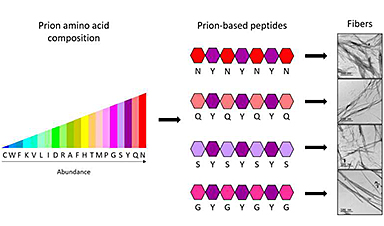Researchers of the Institute of Biotechnology and Biomedicine (IBB-UAB) have generated four peptides, molecules smaller than proteins, capable of self-assembling in a controlled manner to form nanomaterials. The research, published in the journal ACS Nano, was conducted by Salvador Ventura, Marta Díaz Caballero and Susanna Navarro (IBB-UAB), and included the collaboration of Isabel Fuentes and Francesc Teixidor (Institute of Materials Science of Barcelona, ICMAB-CSIC).
In biotechnology, generating functional synthetic amyloid structures to form nanostructures by imitating the natural generation process is not new. The assembly of proteins into stable fibres allows creating supramolecular shapes that no isolated protein can create, and which are used as nanoconductors, photovoltaic structures, biosensors and catalysts.
Quite recently, researchers began synthesizing prion protein sequences to form nanomaterials. The interest in these sequences lies in the fact that the proteins assemble in a slower and more controlled manner, forming highly ordered, nontoxic nanostructures. However, the fact that the sequence is so long, with over 150 amino acids, makes it very difficult and expensive to synthesise.
“We have demonstrated that an adequate design can permit the size of synthetic prion sequences to be reduced down to only 7 amino acids, while conserving the same properties. The four peptides we have fabricated are the shortest structures of this type created until now, and are capable of forming stable fibril assemblies,” says Salvador Ventura, researcher at the IBB and the UAB Department of Biochemistry and Molecular Biology.
Image Credit: Credit: IBB-UAB
News This Week
Repurposed drugs could calm the immune system’s response to nanomedicine
An international study led by researchers at the University of Colorado Anschutz Medical Campus has identified a promising strategy to enhance the safety of nanomedicines, advanced therapies often used in cancer and vaccine treatments, [...]
Nano-Enhanced Hydrogel Strategies for Cartilage Repair
A recent article in Engineering describes the development of a protein-based nanocomposite hydrogel designed to deliver two therapeutic agents—dexamethasone (Dex) and kartogenin (KGN)—to support cartilage repair. The hydrogel is engineered to modulate immune responses and promote [...]
New Cancer Drug Blocks Tumors Without Debilitating Side Effects
A new drug targets RAS-PI3Kα pathways without harmful side effects. It was developed using high-performance computing and AI. A new cancer drug candidate, developed through a collaboration between Lawrence Livermore National Laboratory (LLNL), BridgeBio Oncology [...]
Scientists Are Pretty Close to Replicating the First Thing That Ever Lived
For 400 million years, a leading hypothesis claims, Earth was an “RNA World,” meaning that life must’ve first replicated from RNA before the arrival of proteins and DNA. Unfortunately, scientists have failed to find [...]
Why ‘Peniaphobia’ Is Exploding Among Young People (And Why We Should Be Concerned)
An insidious illness is taking hold among a growing proportion of young people. Little known to the general public, peniaphobia—the fear of becoming poor—is gaining ground among teens and young adults. Discover the causes [...]
Team finds flawed data in recent study relevant to coronavirus antiviral development
The COVID pandemic illustrated how urgently we need antiviral medications capable of treating coronavirus infections. To aid this effort, researchers quickly homed in on part of SARS-CoV-2's molecular structure known as the NiRAN domain—an [...]
Drug-Coated Neural Implants Reduce Immune Rejection
Summary: A new study shows that coating neural prosthetic implants with the anti-inflammatory drug dexamethasone helps reduce the body’s immune response and scar tissue formation. This strategy enhances the long-term performance and stability of electrodes [...]
Scientists discover cancer-fighting bacteria that ‘soak up’ forever chemicals in the body
A family of healthy bacteria may help 'soak up' toxic forever chemicals in the body, warding off their cancerous effects. Forever chemicals, also known as PFAS (per- and polyfluoroalkyl substances), are toxic chemicals that [...]














Leave A Comment